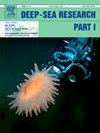Fluid chemistry evolution in deep-sea hydrothermal environments: Unraveling mineral-fluid-microorganism interactions through continuous culture experiment
IF 2.1
3区 地球科学
Q2 OCEANOGRAPHY
Deep-Sea Research Part I-Oceanographic Research Papers
Pub Date : 2025-02-02
DOI:10.1016/j.dsr.2025.104456
引用次数: 0
Abstract
This study investigates minerals and microorganisms effects on fluid chemistry through a continuous enrichment culture in a gas-lift bioreactor during the MoMARsat’19 cruise. A sulfate-based chimney and buoyant hydrothermal fluid, both collected in situ at the Aisics vent of the Lucky Strike hydrothermal field, were incubated for 18 days under physico-chemical conditions simulating those of diffuse hydrothermal vents. We present the evolution of elemental and Sr, and Li isotopic compositions of the bioreactor fluid, alongside Bacteria and Archaea diversity, and analyze the mineral saturation state of the fluid through geochemical modeling. Our results show that the microbial diversity in the bioreactor reflects that of the sulfate-based chimney. During the initial 168 h, minerals precipitation/dissolution primarily controlled the elemental and Sr isotopic composition of the fluid. From 168 h to 264 h, sulfate-reducing Archaea (Archaeoglobi) disappeared in favor of sulfur-reducing Archaea (Thermoprotei and Thermococci). This shift coincides with a drastic increase in trace element concentrations and less radiogenic 87Sr/86Sr ratios, suggesting a possible microbial influence on the fluid. From 264 h onwards, with stable sulfur-reducing archaeal diversity, mineral saturation state primarily controls the elemental composition of the fluid. However, the observed increase in the 87Sr/86Sr ratio and δ7Li correlates with changes in bacterial diversity, notably an increase in Deinococci abundance. This study reveals that in a bioreactor simulating diffuse vent environments related to the sulfur cycle: (i) both microorganism and mineral influence fluid chemistry over time, (ii) shift in microbial diversity appear to affect trace metal concentrations and isotopic signatures, and (iii) the 87Sr/86Sr ratio serves as a tracer for mineral-fluid interactions and may be a tracer for microorganism-fluid interactions.

深海热液环境的流体化学演化:通过连续培养实验揭示矿物-流体-微生物相互作用
本研究通过在MoMARsat ' 19巡航期间在气举式生物反应器中进行连续富集培养来研究矿物和微生物对流体化学的影响。在Lucky Strike热液场Aisics喷口就地收集硫酸盐基烟囱和浮力热液,在模拟弥漫性热液喷口的物理化学条件下孵育18天。研究了生物反应器流体元素、锶、锂同位素组成的演化,以及细菌和古细菌的多样性,并通过地球化学模拟分析了流体的矿物饱和状态。结果表明,生物反应器内的微生物多样性反映了硫酸盐基烟囱的多样性。在最初的168 h中,矿物沉淀/溶解主要控制流体的元素和Sr同位素组成。从168 h到264 h,硫酸盐还原古菌(Archaeoglobi)消失,硫还原古菌(Thermoprotei和Thermococci)取而代之。这种变化与微量元素浓度的急剧增加和放射性87Sr/86Sr比值的减少相吻合,表明可能存在微生物对流体的影响。从264 h开始,具有稳定的硫还原古细菌多样性,矿物饱和状态主要控制流体的元素组成。然而,87Sr/86Sr比值和δ7Li的增加与细菌多样性的变化有关,特别是Deinococci丰度的增加。本研究表明,在模拟与硫循环相关的弥漫性喷口环境的生物反应器中:(i)微生物和矿物都会随着时间的推移影响流体化学,(ii)微生物多样性的变化似乎会影响微量金属浓度和同位素特征,以及(iii) 87Sr/86Sr比值可作为矿物-流体相互作用的示踪剂,也可能是微生物-流体相互作用的示踪剂。
本文章由计算机程序翻译,如有差异,请以英文原文为准。
求助全文
约1分钟内获得全文
求助全文
来源期刊
CiteScore
4.60
自引率
4.20%
发文量
144
审稿时长
18.3 weeks
期刊介绍:
Deep-Sea Research Part I: Oceanographic Research Papers is devoted to the publication of the results of original scientific research, including theoretical work of evident oceanographic applicability; and the solution of instrumental or methodological problems with evidence of successful use. The journal is distinguished by its interdisciplinary nature and its breadth, covering the geological, physical, chemical and biological aspects of the ocean and its boundaries with the sea floor and the atmosphere. In addition to regular "Research Papers" and "Instruments and Methods" papers, briefer communications may be published as "Notes". Supplemental matter, such as extensive data tables or graphs and multimedia content, may be published as electronic appendices.

 求助内容:
求助内容: 应助结果提醒方式:
应助结果提醒方式:


